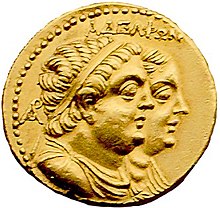Ptolemaic coinage

Coinage of the
The
The first Ptolemaic mint was in
After Egypt was
Design and symbolism

The Ptolemaic Kingdom used
Artistically, Ptolemaic coinage closely followed contemporary
In the coin making process, there were similarities with Seleucid coinage. For instance, Ptolemaic coins often have a central depression from the coin making process.[5][6]
Mints
Coinage was used in the
Tyre was the most important coastal city out of the five Ptolemaic cities with a mint in Syria.[2] After the Seleucid Kingdom led by Antiochus III the Great conquered Coele-Syria Ptolemais in Phoenicia (Acre) was still allowed to strike coins using the Phoenician weight. The mint remained very prolific, and was among the most active ones in the Seleucid Kingdom.[8][9] It is likely that the city struck silver coinage without an interruption after it changed hands, as it was a very important city in Phoenicia.[9] However, the Seleucids discontinued a Ptolemaic mint in Jaffa.[3]
In Greece, Ptolemaic coinage mainly originates from the Peloponnese and Euboea. Corinth did not strike Ptolemaic coinage during its brief subordination to the kingdom.[2]
Cyprus had many important mints, and the island struck large amounts of Ptolemaic coinage from 200 BC to 80 BC.[2] Cyprus was also richer in silver than Egypt.[10] In the second century BC, most of the Cypriot coinage are easily identifiable and datable because they include abbreviations for mints and dates for both gold and silver coinage. Cypriot mints from this period include Salamis (abbr. ΣA), Kition (abbr. KI) and Paphos (abbr. Π, and later as ΠA).[11] Meanwhile, at Crete, there was no royal coinage in use, and Cretan cities had a strong autonomy of minting their own coins.[2]
There are no evidence that Ptolemaic mints existed in
History

Background
Silver was scarcer than gold in Egypt, and the exact ratio of their value is unclear. Silver was however probably shipped in significant quantities from abroad.[12] In addition, Ptolemaic Cyprus produced some silver for coinage struck locally.[10]
Coinage was not used in Egypt during pre-Ptolemaic
Monetary isolation

The Ptolemaic Kingdom did not use the Attic weight, or Attic standard, which was very common in other contemporary
During most of the Ptolemaic Kingdom's history, it was a policy that all foreign coinage within Egypt would be confiscated by the state and replaced with Ptolemaic currency. Parallels between
Yehud coinage
Palestine region and Judea came under Ptolemaic control when Ptolemy I Soter took control of Yehud Medinata in 320 BC. But there was considerable instability in the area after his rule there was challenged.
The minting of small denomination coins continued, for example coins with Ptolemy and Berenike.[17] Minting of some local coins was allowed with the names of local magistrates.[18]
The Ptolemaic coins minted in Judea carried only the Hebrew letters YHD (Yehud), and no Greek lettering.
Neighboring Seleucid Kingdom's policy was also not so strict in imposing the royal control on mints.[2]
During the reign of
As it became increasingly difficult to obtain silver for the Ptolemaic kingdom, bronze coinage largely replaced silver in Egypt. Furthermore, monetary isolation was increased by other factors, like considerable inflation and the use of a unique standard to replace the Attic weight.
Roman era
After the demise of the Ptolemaic Kingdom, Egypt became a
See also
- Egyptian gold stater
- Rhodian coinage
- Coinage of Side
- Coinage of the Kingdom of Pontus
- Seleucid coinage
References
- ISBN 978-0-521-39504-5.
- ^ ISBN 90-04-04490-6.
- ^ ISBN 978-0-521-21880-1.
- ^ Fulinska, Agnieszka (2010). "Iconography of the Ptolemaic queens on coins: Greek style, Egyptian ideas?". Studies in Ancient Art and Civilization. 14. Retrieved 22 December 2017.
- ISBN 978-0-521-39504-5.
- ISBN 978-1-107-60599-2.
- ISBN 978-0-520-08329-5.
- ^ ISBN 978-1-134-87783-6.
- ^ a b Newell, Edward T. "The first Seleucid coinage of Tyre". Digital Library Numis (DLN). pp. 1–2. Retrieved 22 December 2017.
- ^ ISBN 978-1-4969-9020-4.
- ^ "The Coinage of the Ptolemies in Cyprus". kyprioscharacter.eie.gr. Retrieved 22 December 2017.
- ^ JSTOR 3854105.
- ^ JG Manning (December 2006). "Coinage as 'code' in Ptolemaic Egypt" (PDF). Stanford University. Retrieved 22 December 2017.
- ISBN 978-1-108-02062-6.
- ^ ISBN 978-1-108-07865-8.
- ^ Gitler H., Lorber C., Fontanille J.-P. (2023), The Yehud Coinage: A Study and Die Classification of the Provincial Silver Coinage of Judah. (Introduction) Israel Numismatic Society; Jerusalem, Israel.
- ^ The Menorah Coin Project website. Israel Numismatic Society. See Section 3. "Ptolemaic period"
- ^ Lorber, C. C. (2018). Coins of the Ptolemaic empire. Part I: Ptolemy I through Ptolemy IV. Volume 1: Precious metal. New York: American Numismatic Society
- ^ The Menorah Coin Project website. Israel Numismatic Society. See Section 3. "Ptolemaic period"
- ^ Gitler H., Lorber C., Fontanille J.-P. (2023), The Yehud Coinage: A Study and Die Classification of the Provincial Silver Coinage of Judah. (Introduction) Israel Numismatic Society; Jerusalem, Israel.
- . Retrieved 27 May 2018.
- ISBN 978-1-316-06089-6.
Bibliography
- Lorber, Catharine (2018). Coins of the Ptolemaic Empire I: Ptolemy I through Ptolemy IV. New York: American Numismatic Society. ISBN 9780897223560.
- Faucher, Thomas; Meadows, Andrew; Lorber, Catharine (2017). Egyptian hoards I:The Ptolemies. ISBN 9782724706895.
